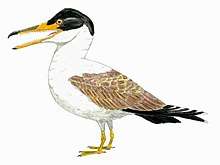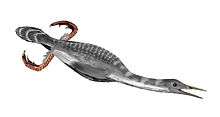Alexornis
Alexornis is a genus of enantiornithine birds from the Bocana Roja Formation of Baja California, Mexico.[1] This geological formation has been dated to the late Cretaceous period, and more specifically to the Campanian age, about 73 mya. The type and only known species is Alexornis antecedens. Its name means "Alex's ancestral bird"; Alexornis from the given name of ornithologist Alexander Wetmore + Ancient Greek ornis, "bird", and antecedens, Latin for "going before" or "ancestral".[2]
| Alexornis | |
|---|---|
| Scientific classification | |
| Kingdom: | Animalia |
| Phylum: | Chordata |
| Clade: | †Enantiornithes |
| Order: | †Alexornithiformes Brodkorb, 1976 |
| Family: | †Alexornithidae Brodkorb, 1976 |
| Genus: | †Alexornis Brodkorb, 1976 |
| Species: | †A. antecedens |
| Binomial name | |
| †Alexornis antecedens Brodkorb, 1976 | |
A. antecedens is known only from a single fragmentary skeleton including shoulder, wing, and leg bones, but lacking a skull. It was about the size of a sparrow.[3] The specimen was discovered in 1971 and described and named in 1976 by Pierce Brodkorb. Brodkorb considered the species to be similar to some modern birds, and at the time, recognized it as one of the few known Cretaceous "land birds" after Gobipteryx minuta (most other Cretaceous birds at the time were thought to be aquatic or semi-aquatic).[2]
Classification
Alexornis was originally described as an early member of the modern bird group and, more specifically, as a possible ancestor of the orders Coraciiformes (kingfishers and relatives) and Piciformes (woodpeckers and relatives). However, when the first recognized enantiornithine fossils were discovered, it soon became clear that Alexornis was an additional member of this group.[3] Enantiornithes are characterized by a reversed articulation of the scapula and coracoid bones in the shoulder, and in 1983 Larry Martin showed that Brodkorb has accidentally switched these two bones in his original description, confused by their reversed anatomy.[4]
In the past, Alexornis has been allied with the similarly-sized Central Asian genus Kizylkumavis, based on characteristics which are known to unite them with other Cretaceous birds in the group Enantornithes.[3] Evgeny Kurochkin argued in 1996 that Alexornis formed a natural group, the Alexornithidae, with Kizylkumavis and a second type of central Asian bird, Sazavis. Among the enantiornithes, Alexornis shares many similarities of its skeletal anatomy with South American birds from about the same time period, including Martinavis and Elbretornis, and is united with them in the group Euenantiornithes.[5]
References
- Tykoski, R. S., & Fiorillo, A. R. (2010). An enantiornithine bird from the lower middle Cenomanian of Texas. Journal of Vertebrate Paleontology, 30(1), 288-292.
- Brodkorb, Pierce (1976): Discovery of a Cretaceous bird, apparently ancestral to the orders Coraciiformes and Piciformes (Aves: Carinatae). Smithsonian Contributions to Paleobiology 27: 67-73. PDF fulltext (File size 70MB!)
- Walker, C. A., Buffetaut, E., & Dyke, G. J. (2007). Large euenantiornithine birds from the Cretaceous of southern France, North America and Argentina. Geological Magazine, London, 144(6), 977.
- Martin, L. 1983. The origin and early radiation of birds. In Perspectives in Ornithology, Essays Presented for the Centennial of the American Ornithologists’ Union, pp. 291-338.
- Walker, C. A., & Dyke, G. J. (2009). Euenantiornithine birds from the late Cretaceous of El Brete (Argentina). Irish Journal of Earth Sciences, 27(1), 15-62.
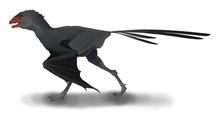

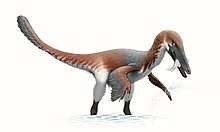
.png)



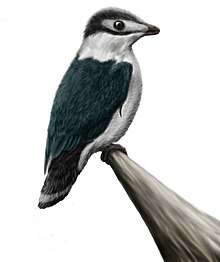

.png)

